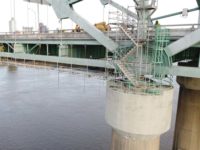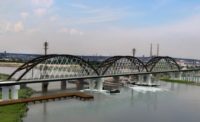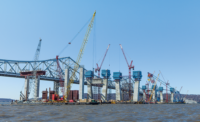New York and New Jersey officials, with U.S. Dept. of Transportation Secretary Pete Buttigieg, held a groundbreaking ceremony for construction of the $1.6-billion Portal Bridge Aug. 1. But the joint venture team of Skanska/Traylor Bros. PNB has already started preparatory work on the rail span, such as grubbing and clearing, and establishing a site office.
Spanning over two miles of the Northeast Corridor rail line, the elevated Portal North Bridge Project will replace the existing elevated bridge with a two-track, high-level, fixed-span bridge designed to improve rail service and capacity along the corridor. The bridge will rise 50 ft as it crosses over the Hackensack River.
The project is funded by the U.S. Department of Transportation, New Jersey, New York and Amtrak. In January 2021, New Jersey Gov. Phil Murphy (D) announced the signing of a Full Funding Grant Agreement, which secured $766.5 million in Federal Transit Administration funding to support the project’s construction.
In October 2021, Murphy and New Jersey Transit announced the approval of a nearly $1.6-billion construction contract to Skanska/Traylor Bros PNB Joint Venture (STJV). The contract represents the single largest construction award in NJ Transit’s history. STJV received a Notice to Proceed in April. Completion is expected in about 5.5 years.
The project spans 2.44 miles of the Northeast Corridor rail line. It includes construction of retaining walls, deep foundations, concrete piers, structural steel bridge spans, rail systems, demolition of the existing bridge, and related incidental works.
The main span will be 1,200 ft long and consist of three tied arches, each 400 ft long x 57 ft wide x 86 ft high, says Keith Chouinard, Skanska’s general manager for the project.
“One of the challenges is location,” Chouinard adds. “Obviously, it’s in a location not accessible by normal means, next to a railroad. We’ll use temporary trestles to access the work, especially for large equipment.”
Crews will have to work while up to 450 Amtrak and NJT trains continue to run daily. “The number one priority besides safety” is minimal disruption of service," says Chouinard.
The main span sections will be prefabricated offsite, and lifted into place. Each of the three sections will weigh about 2,700 tons, Chouinard adds. The bridge will sit on drilled shafts as large as 8 ft in diameter.
The existing bridge's lowest beams are 23 ft above the Hackensack River. The new bridge’s 50-ft clearance will allow marine traffic to pass underneath without delays. The horizontal clearance will improve from 90 ft to 270 ft in the channel, according to Skanska.
There will be 52 approach spans, each comprising up to eight girders approximately 9 ft tall and up to 140 ft long, adds Chouinard.
Portal Partners, a joint venture between Gannett Fleming Transit & Rail Systems, HNTB Corp., and Jacobs Engineering Group Inc., won the design contract in 2008. The original plan was to build two parallel bridges, one to either side of the old one, but due in part to cancellation of the Access to the Region's Core project by then New Jersey Gov. Chris Christie, in 2010, the plan was reduced to a single two-track bridge constructed north of the existing bridge, with room for a future bridge to the south.






Post a comment to this article
Report Abusive Comment